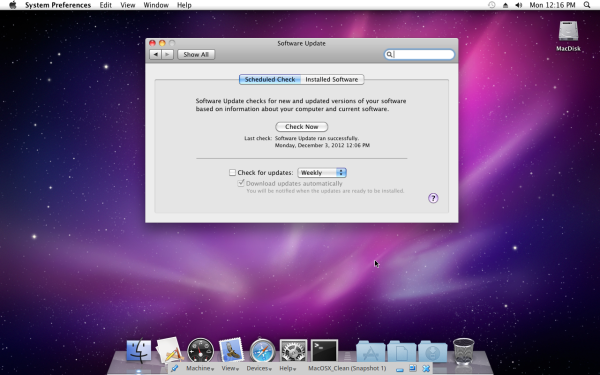Mac Linux Usb Loader Download Dmg
Mac Linux USB Loader
- Unetbootin
- Mac Linux Usb Loader Download
- Mac Linux Usb Loader Download Dmg Windows 7
- Mac Os Dmg File Download
Mac Linux USB Loader allows you to put a Linux distro on a USB drive and make it bootable on Intel Macs using EFI. Main features: - Create a live USB stick with a Linux distribution that can boot on Intel Macs natively without requiring rEFIt/rEFInd. MacOS Mojave 10.14 dmg for mac free download full version.MacOS Mojave 10.14(18A391) offline installer complete setup for mac OS with direct link. Description MacOS Mojave 10.14 Dmg For Mac. If you're ready to try Linux on your Mac, this guide to dual-booting Ubuntu and Mac OS takes you through the process step by step. It is probably in your Downloads folder. Double-click the.dmg file to mount the image on your Mac's desktop. The UNetbootin image opens. It can, however, properly create the bootable USB drive when it.
Tool allowing you to put a Linux distribution on a USB drive and make it bootable on Intel Macs using EFI.
General Information
This is the Mac Linux USB Loader, a tool allowing you to take an ISO of a Linux distribution and make it boot using EFI. It requires a single USB drive formatted as FAT with at least 2 GB free recommended. Mac Linux USB Loader is available under the 3-clause BSD license.
The tool is necessary to make certain Linux distributions boot that do not have EFI booting support. Many distributions are adding this with the release of Windows 8, but it has not been finalized and is still nonstandard by most distributions. Many common distributions are supported, like Ubuntu and Linux Mint.
If you wish to contribute to the code or fork the repository, please do so. All development currently takes place on the master branch, and this is where code should be submitted for pull requests. The legacy branch contains the code for pre-3.0 versions of Mac Linux USB Loader; it will not be maintained and is present for historical interest only.
I created this tool, if you care, for several reasons:
- None of the other tools available (esp. unetbootin) feel native and operate as you would expect on the Mac platform.
- None of the other methods of which I am aware have the ability to make the archives boot on Intel Macs.
- It was personally a pain in the neck getting Linux distributions to boot via USB on Macs.

That being said, it does have a few shortcomings:
- Linux fails to have graphics on some Macs (i.e Macbook Pros with nVidia graphics), which in some cases prevents boot, but this is not necessarily an issue with Mac Linux USB Loader as much as it is an issue with the video drivers that ship with most distributions. Luckily, with Enterprise, which has been included with Mac Linux USB Loader since 2.0, you can use persistence to install the necessary video drivers on distributions like Ubuntu, helping to alleviate the issue.
Building from Source
Requirements: Xcode 9, OS X 10.12 SDK. OS X 10.8+ required to run built app
- Clone from git:
git clone https://github.com/SevenBits/Mac-Linux-USB-Loader.git - Run
pod install(requires Cocoapods). - Open
Mac Linux USB Loader.xcworkspaceand do an archive build, or simply run and debug it with Xcode
Mac Linux USB Loader utilizes the OS X app sandbox, and so it requires that it be code-signed to use all features. This should not be a problem if you are a registered Apple developer.
Acknowledgements
- Used some icons from KDE's Oxygen
- Mac Linux USB Loader icon by Todd Gaunt
- Special thanks to Leander Lismond for translating the application into Dutch!
- Special thanks to Stephan Rusch for translating the application into German!
- Special thanks to Cai Argimon for translating the application into Spanish!
- Special thanks to Daniele Isoni for translating the application into Italian!
- Special thanks to Uhucream (@TK_CH291) for translating the application into Japanese!
- Special thanks to Thor-Jakob G. Løberg for translating the application into Norwegian Bokmål!
- Special thanks to lightsing for translating the application into Simplified Chinese.
So you’re running Linux on your computer, maybe Ubuntu, and you have some files with the .dmg extension. In this guide, we’re going to talk about how to open, mount, extract, and otherwise get your files from these pesky DMG images. You could always just extract the files on a Mac, then transfer them back to your Linux machine. But if you really want to do this on Linux, without having to rely on Mac, here’s how to do it.
What are DMG image files?
Simply put, it’s a kind of image file. But not an image like a jpeg is an image. DMG is Apple’s proprietary disk image format, native to Mac OS X. There are actually a whole bunch of different types, format and options within this format. There are options for encryption, compression, and different kinds of partition schemes, among others. Unfortunately, this can make things pretty confusing when we’re trying to gain access to the data contained in one of these images.
DMG images are typically a kind of Universal Disk Image Format (UDIF), although there are others, namely NDIF and SPARSE. Although the .dmg file extension is usually used, they can also sometimes have an .img extension, or in some cases no extension at all. Their MIME type is application/x-apple-diskimage.
The HFS/HFS+ (Mac OS Extended/Journaled) file system is typically used in DMGs. However, this isn’t always the case. You may also sometimes find FAT and ExFAT files systems, as well as variations on HFS.
Does my system support DMG?
Perhaps the biggest hurdle to overcome when trying to work with DMG files is working with the HFS file system (Mac OS Extended). Linux supports HFS through the “hfs” and “hfsplus” kernel modules.
There’s an easy way to test if your system has these kernel modules. Plug in a USB drive formatted with the Mac OS Extended file system. If your particular distribution doesn’t have the appropriate modules, you will likely get an error message. On Ubuntu, you’ll get a popup window declaring “Ubuntu: Unable to mount
Alternatively, we can see if the kernel module files are present with find:
We want to see two files: “hfs.ko” and “hfsplus.ko”. If find doesn’t return these files, your system probably doesn’t support HFS.
You could also try “modinfo”: modinfo hfs and modinfo hfsplus should return something like:
If you get 'modinfo: ERROR: Module hfsplus not found' your system doesn’t have these modules.
Not all Linux kernels and distributions support HFS. This is especially the case for certain distributions that are a few years old. If you have kernel support for HFS, great! If not, don’t worry. There are still ways to extract data from your DMG files. While it’s nice to have the option to mount the images we’re working with, this is really the only functionality we’re losing without having the hfs and hfsplus modules. The two programs we’re going to use later on (P7ZIP and dmg2img) do not require kernel support to function.
What kinds of DMG images can be opened in Linux?
This guide is about how to open, mount, and extract files from read/write, read only, and compressed DMG image files. The following partition schemes have all been tested with the techniques discussed here.
- Apple Partition Map
- CD/DVD (partitioned)
- CD/DVD (partitioned) with ISO data
- Hard disk
- Master Boot Record Partition Map
- No partition map
This guide does not cover how to handle sparse disk images (.sparseimage), sparse bundle disk images (.sparsebundle), or CD/DVD masters. DMG images with partition scheme types of “CD/DVD” and “GUID Partition Map” do not appear to work with the techniques described here.
Option 1: Mount the DMG
If the Linux distribution you’re on has HFS support in the kernel (Ubuntu 14.04.1 LTS supports it), it’s pretty easy to just mount the DMG image:
We’re using “sudo” because we need root privileges to mount things. The HFS+ file system type is specified with “-t hfsplus”. The “/mnt” at the end of the command specifies where we’re mounting the image.
Unmount the image with sudo umount /mnt
If you get a wrong fs type message like the one below, it means the DMG file is either of an unsupported type, or it’s compressed. Unsupported images include sparse images, sparse disk bundles, CD/DVD masters, and images with partition schemes of the CD/DVD or GUID Partition Map types.
Unetbootin
Use “file” to learn a little more about the image file:

If you get image.dmg: x86boot sector that means it’s probably using a GUID Partition Map and isn’t supported. This isn’t good, however, it’s also not too terribly common.
What’s more common is to see something like this:
If mounting isn’t working, and this is what you’re seeing with “file image.dmg”, then you’re luck!. Our problems are being caused by compression. Linux doesn’t like to mount compressed DMG images. To get around this little obstacle, we’ll use dmg2img (see below).
Option 2: Use dmg2img for compressed images
Mac Linux Usb Loader Download
So you have a DMG image that you can’t mount because it’s compressed. You’ve done “file compressed_image.dmg” and you got “compressed_image.dmg: bzip2 compressed data”. The fix? That’s easy: use dmg2img to convert it to an uncompressed image. Once you run the image through dmg2img you should be able to mount it no problem.
Don’t have dmg2img? It’s usually pretty easy to get using your distribution’s package management. On Ubuntu, you’d do:
Using dmg2img isn’t very difficult. Type “dmg2img” into the command line followed by the name of the DMG file you want to decompress. The Mac OS X version of Firefox is a good example of a compressed DMG file.
How to assemble the pkg and pfpkg into dmg file. There's no need to use anything other than cat, if I understood your intention correctly: cat /var/lib/dpkg/info/.conffilesshould give you what you're after.
Mac Linux Usb Loader Download Dmg Windows 7
Now mount the resulting .img file:
Option 3: Extract DMG contents with P7ZIP
P7ZIP is awesome. It’s the Linux/BSD version of 7-Zip. Check out their SourceForge page here With it you can literally extract files from any kind of image or archive. Just kidding… It doesn’t really work with every format conceivable. However, it can handle (in alphabetical order): ARJ, CAB, CHM, CPIO, CramFS, DEB, DMG, FAT, HFS, ISO, LZH, LZMA, MBR, MSI, NSIS, NTFS, RAR, RPM, SquashFS, UDF, VHD, WIM, XAR and Z. Impressed? I certainly am!
Installing p7zip is pretty easy using your distribution’s package management system. On Ubuntu with apt-get:
In addition to being able to extract data from compressed and uncompressed images alike, P7ZIP doesn’t require the HFS kernel modules at all. In the example below, we’re going to extract all of the files from “Firefox 33.1.1.dmg”. When we’re done, we’ll have a tidy little folder called “Firefox”.
Mac Os Dmg File Download
Invoke P7ZIP to extract archives and images with “7z x”.
Notice that 7z extracted three files: “0.ddm”, “1.Apple_partition_map”, and “2.hfs”. To actually get to the files, we’ll need to run 7z again on “2.hfs”.
We picked “2.hfs” because it was the biggest of the three, meaning it was probably the one with the data. Simple but effective logic. After a few moments, you should have a folder called “Firefox” with all of the files from the original DMG.